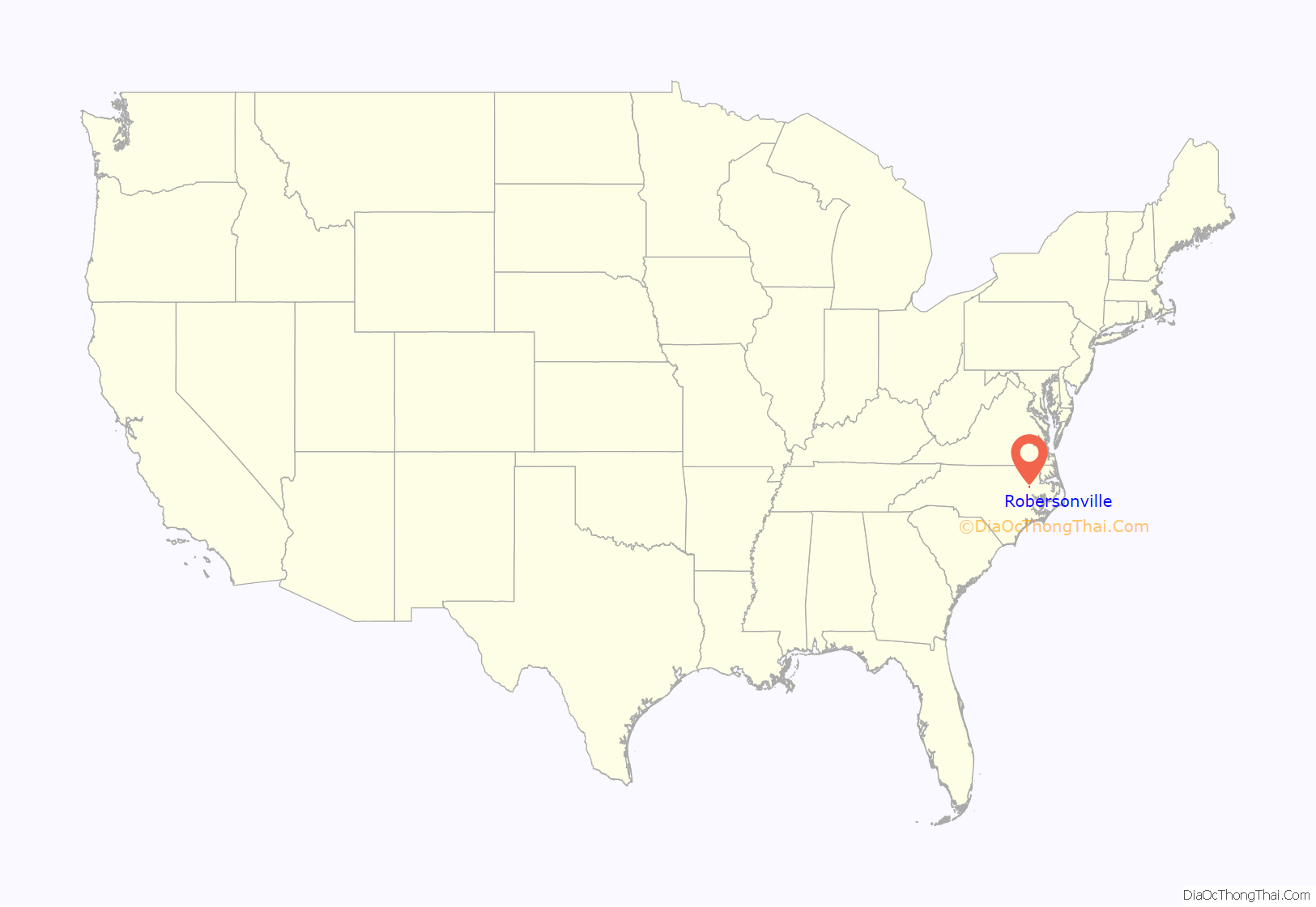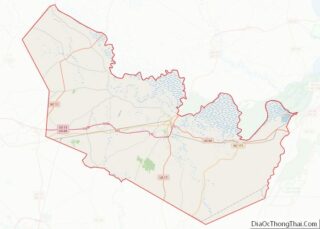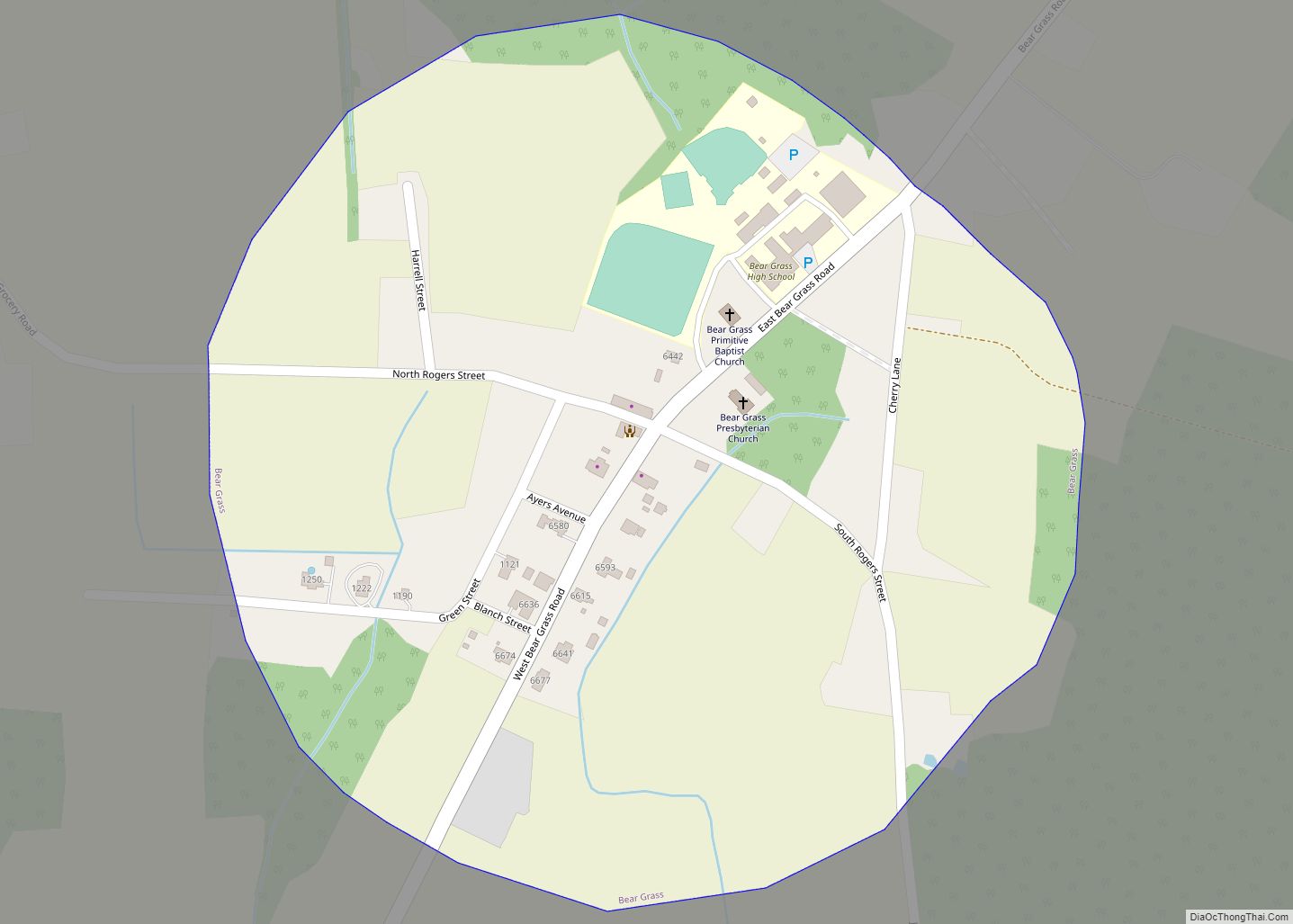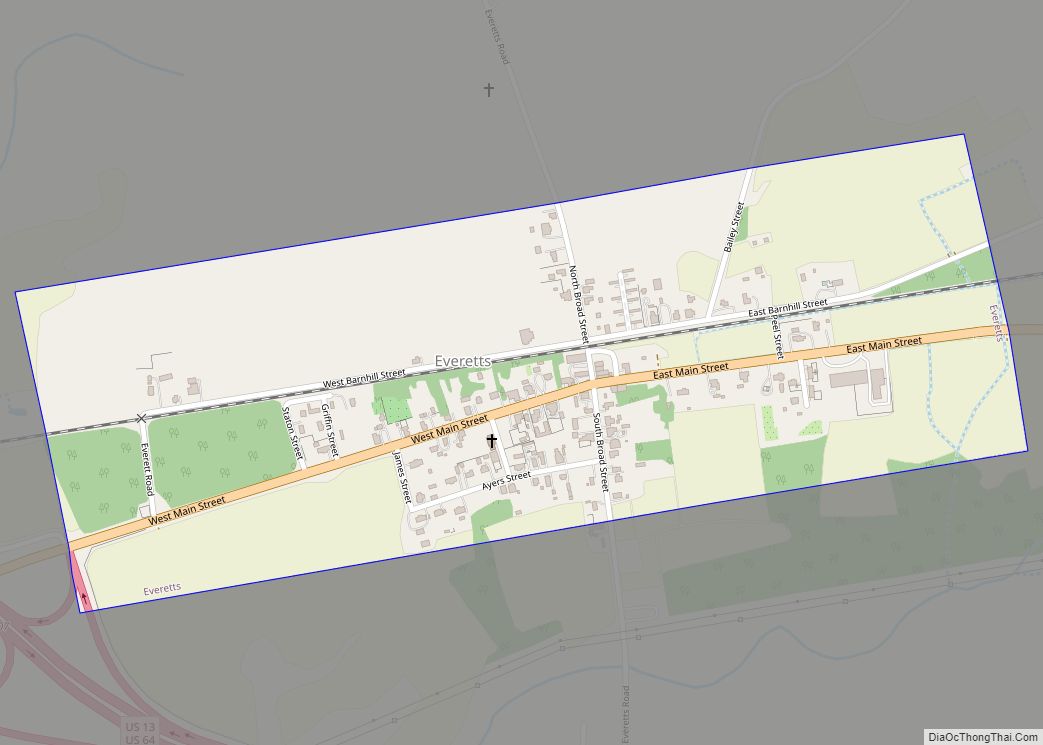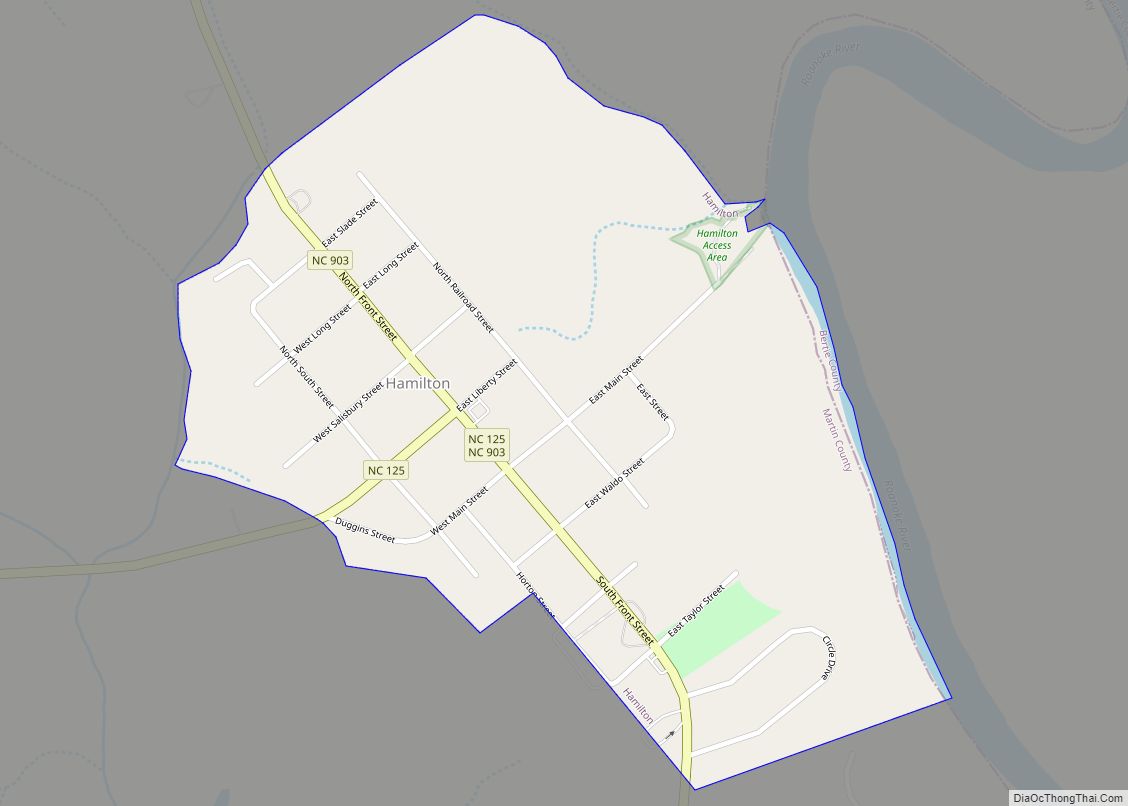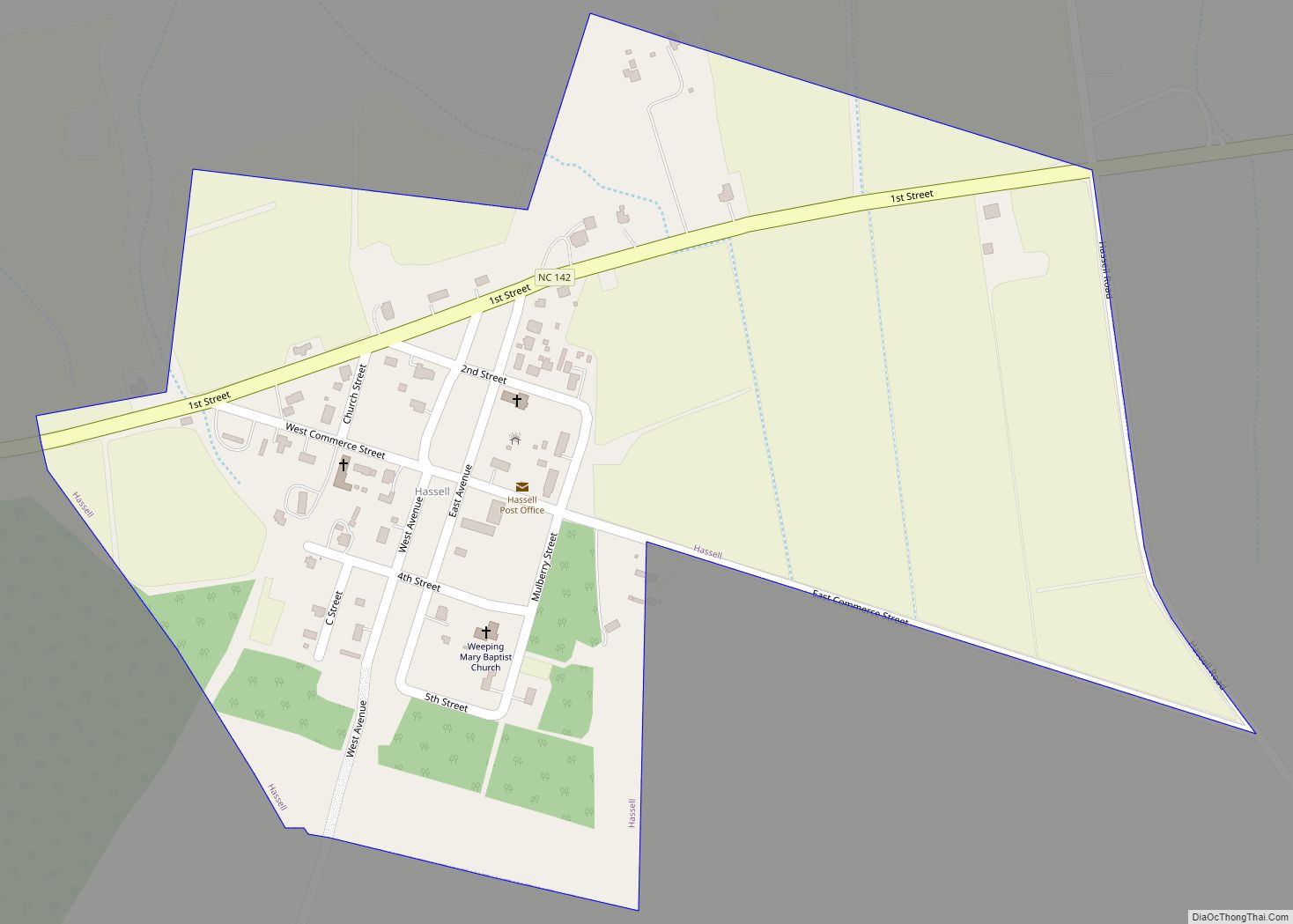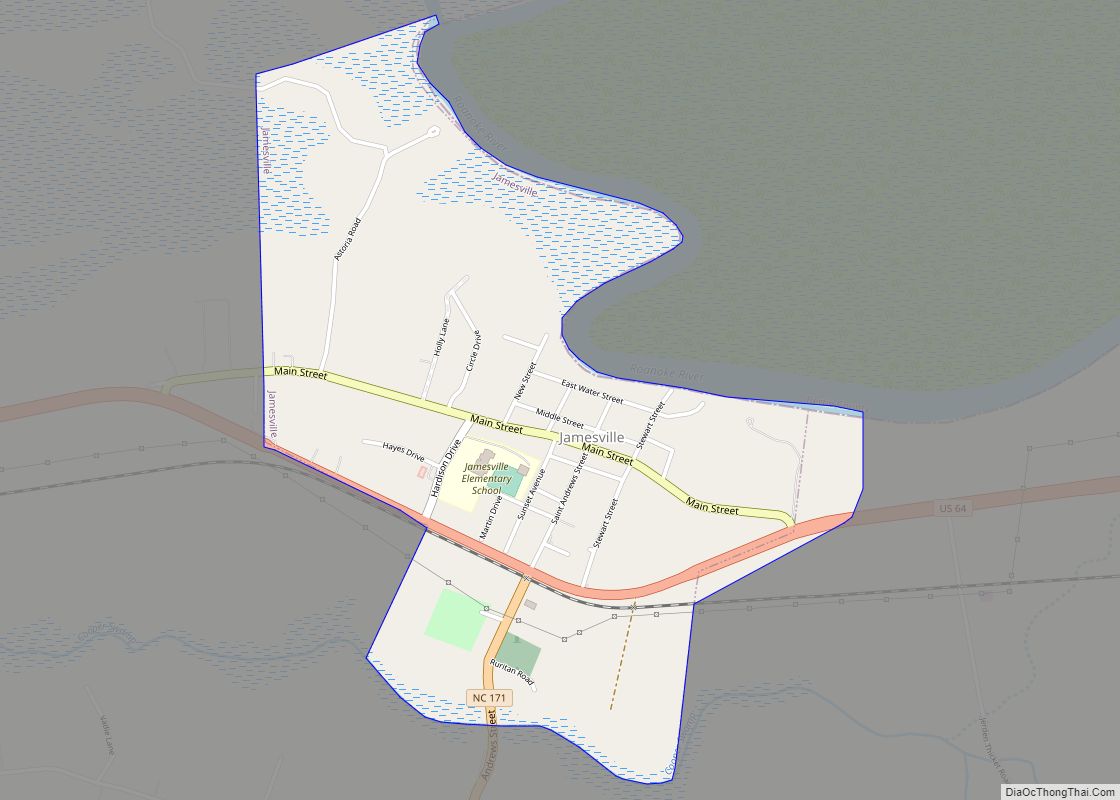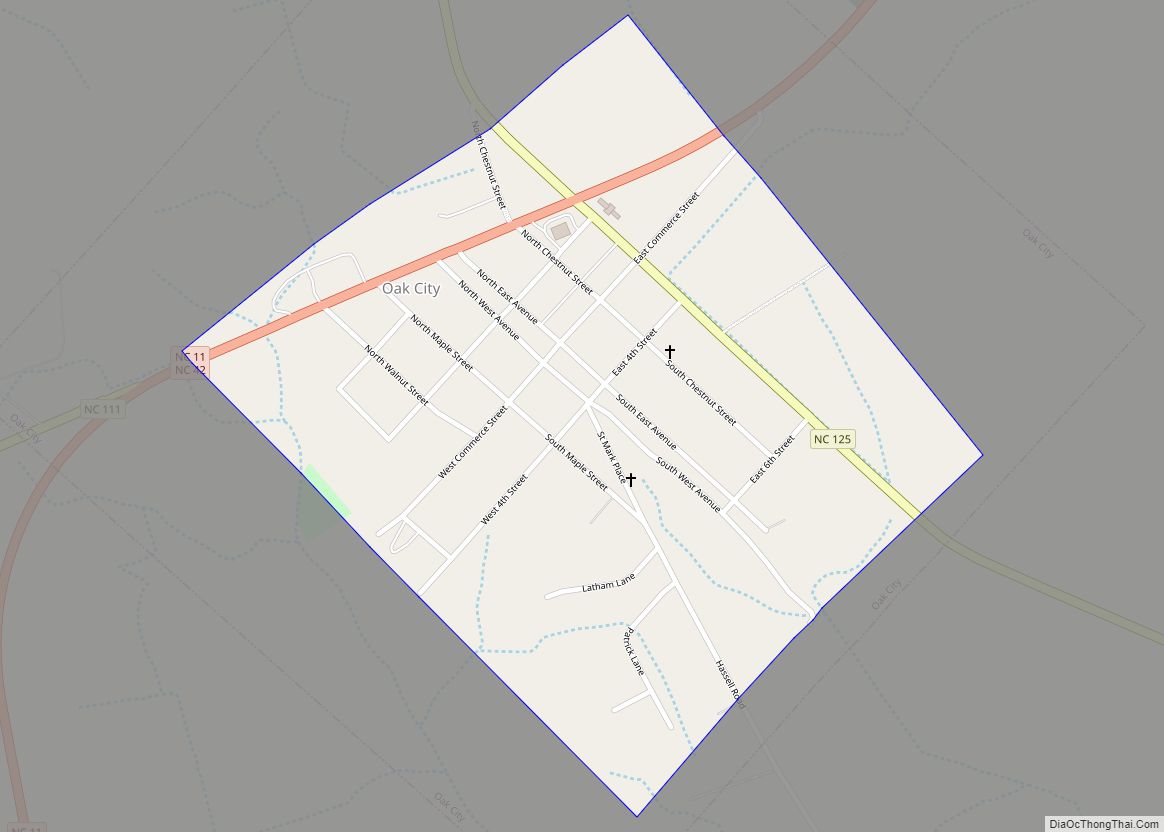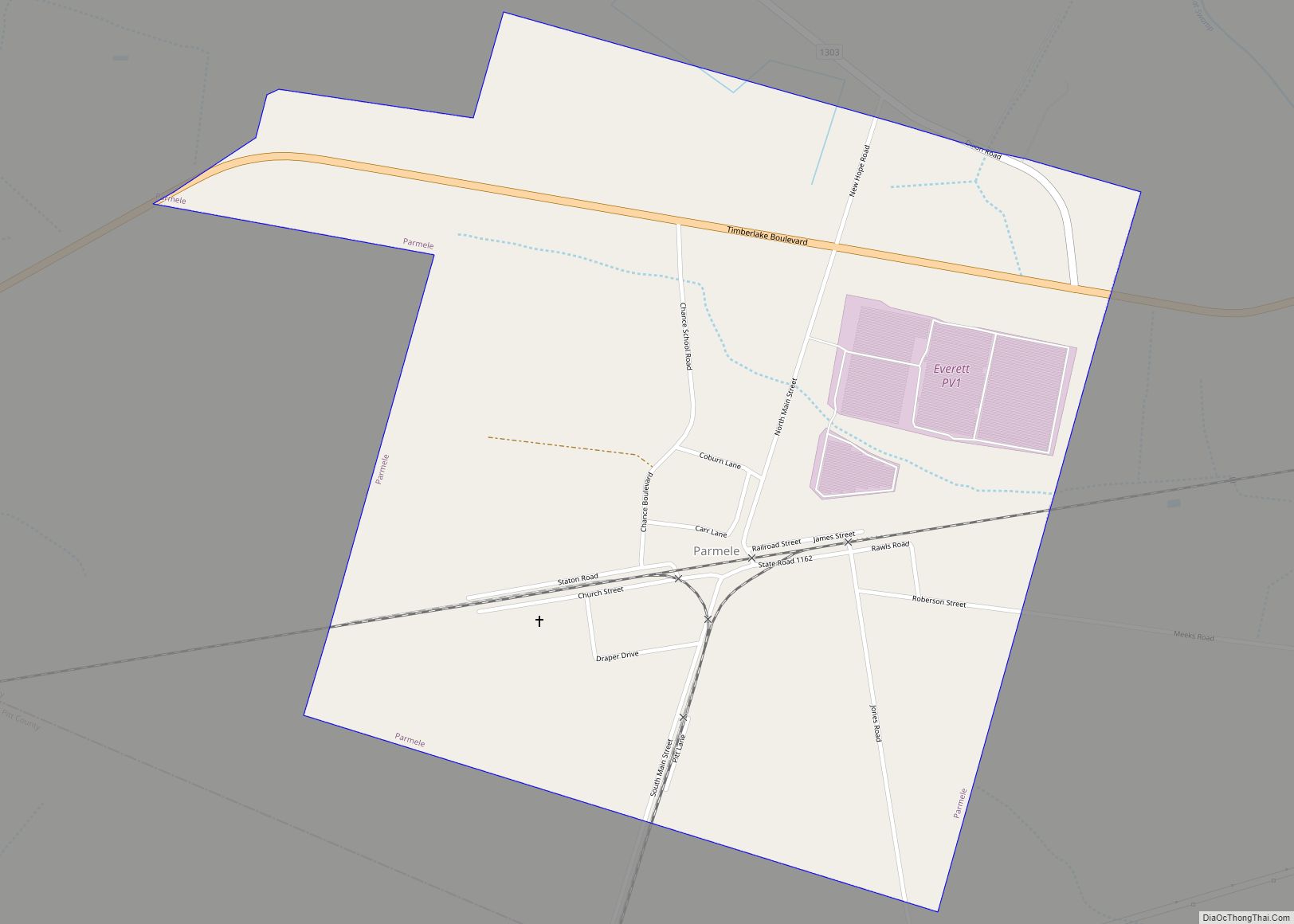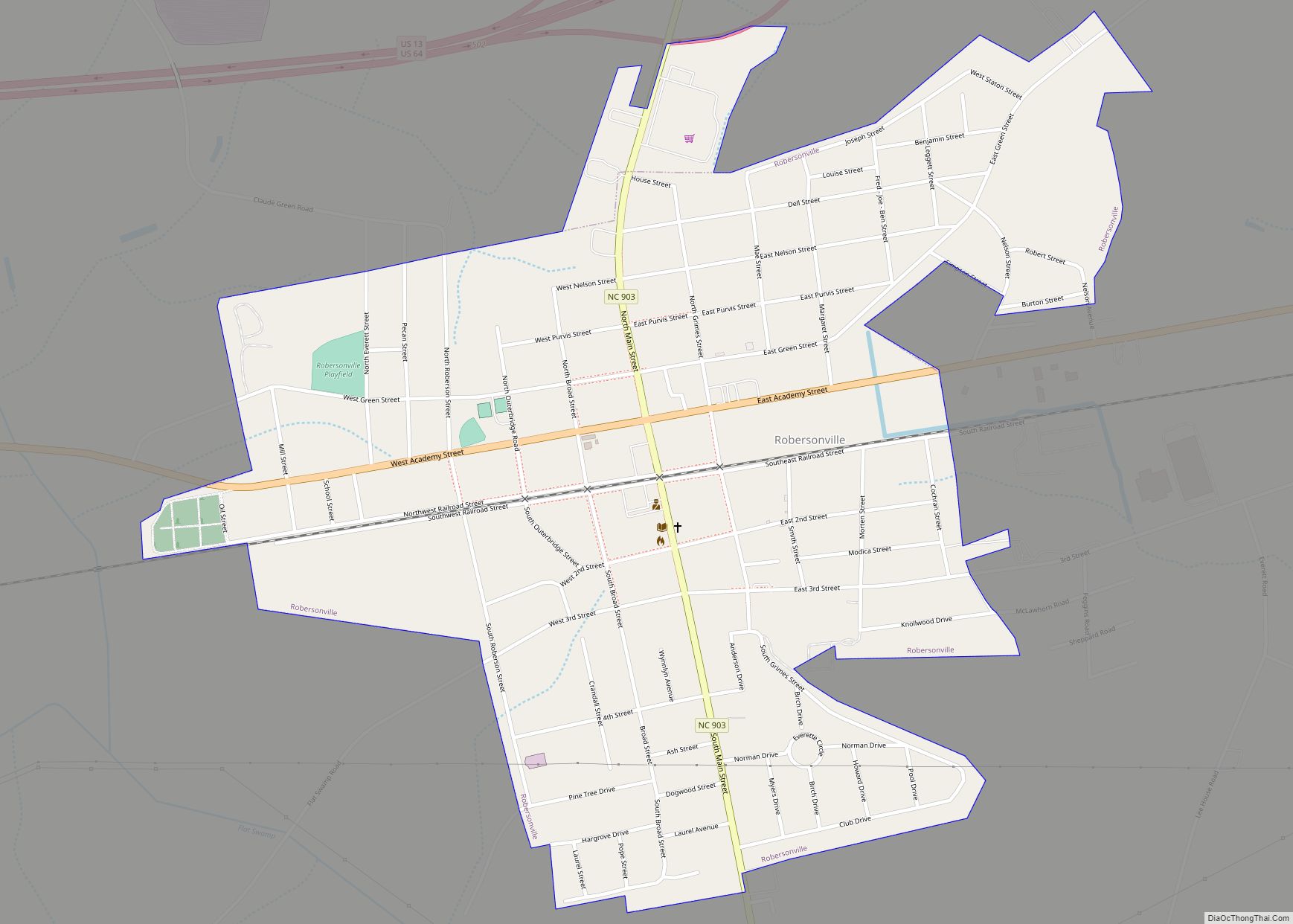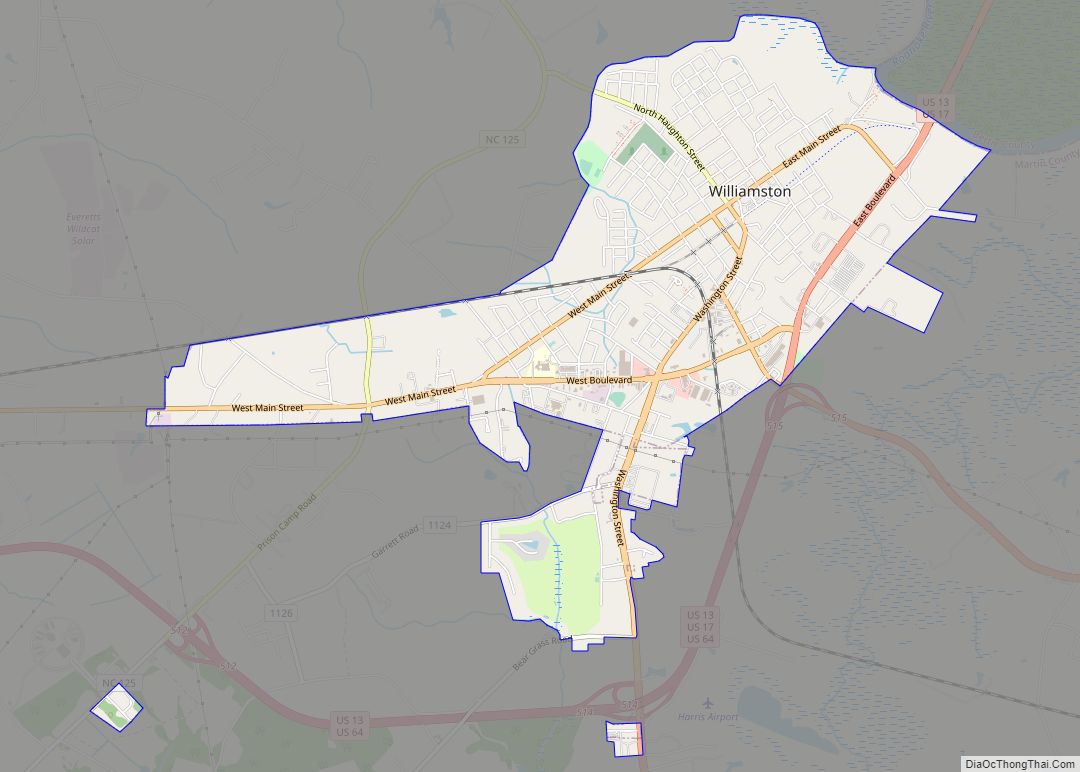Robersonville, incorporated in 1872, is a town located in Martin County, North Carolina, United States. The population was 1,326 at the 2020 census. Robersonville is located in North Carolina’s Inner Banks region. It is home to the East Carolina Motor Speedway.
| Name: | Robersonville town |
|---|---|
| LSAD Code: | 43 |
| LSAD Description: | town (suffix) |
| State: | North Carolina |
| County: | Martin County |
| Elevation: | 72 ft (22 m) |
| Total Area: | 1.21 sq mi (3.14 km²) |
| Land Area: | 1.21 sq mi (3.14 km²) |
| Water Area: | 0.00 sq mi (0.00 km²) |
| Total Population: | 1,269 |
| Population Density: | 1,047.03/sq mi (404.28/km²) |
| ZIP code: | 27861, 27871 |
| Area code: | 252 |
| FIPS code: | 3757100 |
| GNISfeature ID: | 1024267 |
| Website: | https://www.townofrobersonville.com/ |
Online Interactive Map
Click on ![]() to view map in "full screen" mode.
to view map in "full screen" mode.
Robersonville location map. Where is Robersonville town?
History
The earliest known citizens of the Robersonville area were the Tuscarora and Morotock Native Americans. However, according to various deeds, family bibles, wills, and church records, settlers arrived many years before the Revolutionary War. One of the earliest known churches of the area was Flat Swamp Primitive Baptist Church, founded in 1776. Among the early settlers of this area was the family of Henry Robason, who is said to have been born in 1710 in England. Eventually the family name became “Roberson” and the family tree grew throughout the region. Before the Civil War, George O. Roberson and his father, William, owned a store originally located on the northwest corner of what is now known as Railroad and Roberson Streets. The local militia trained at this store during the Civil War. After returning from the war, George built a store across the street from the original one.
When the town was incorporated February 16, 1872, it became the first town in Martin County not located on the Roanoke River; thus, it wasn’t dependent on the river for communication with other settlements. Instead, the railroad was the main artery of communication and trade. The town was named after Henry, William, and George Roberson. Of the 3 brothers, Henry D. Roberson is considered to the “Father of Robersonville.” He served as director, stockholder, and one of the foremost promoters of the railroad that ran from Williamston to Tarboro. It was first known as the Williamston and Tarboro R.R., but, the name was soon changed to Seaboard and Raleigh R.R., then the Albemarle and Raleigh R.R., and is now part of the Atlantic Coast Line system. Although the Seaboard and Raleigh Railway Company would not be incorporated until late 1873, town founders envisioned it as a prominent trading center and market for western Martin County. Growing slowly during its first decade, after the railroad’s completion in October 1882, the town had eleven general stores, two physicians, and a number of industries by 1884. The population was then 400 residents, with an influx of farm families and ambitious young men moving here because of various entrepreneurial, educational, and social opportunities. The first mayor was William W. Roberson. The original town commissioners were Henry D. Roberson, Staton Everett, and Eli Askew. Vance L. Roberson served the longest tenure of public service of any Robersonville citizen. Henry Staton Everett served longer than any other mayor.
In the late 1800s, the Jewish Agricultural Society, helped many Jewish families relocate from Russia to the United States. While most of these families settled in the Northeast, a few were relocated to eastern North Carolina due to its agrarian-based economy and abundance of affordable land. Most notably the Margolis, Levy, and Bernstein families came to the Robersonville area in the early 1900s and took to farming in addition to owning department stores and shops. In 1902, Adath Shalom (Congregation of Peace) was established. The first synagogue was built in 1907 and existed until it caught fire in the late 1940s. Afterward, most families attended religious services in nearby Rocky Mount. The handful of Jewish families, which resided in Robersonville and nearby Williamston, either died or relocated to larger cities with the Margolis family being one of the last to leave in the 1990s.
Postal Service began on July 10, 1874, with Wilson T. Outterbridge as the first postmaster. Mrs. Geneva Weaver served the longest term of any Robersonville postmaster. The first electric plant was built around 1914 and was privately owned and operated. Around 1940, the town contracted to buy current from Greenville. After World War II, a contract was negotiated with Virginia Electric & Power. Later, Carolina Power & Light was used. At one time, J.S. (Jim) Simpson supervised the distribution and maintenance of electricity, under the direction of Town Manager James E. Gray and Clerk Alice Briley. Today, the town has a contract with Electricities, Inc. The water and sewage disposal system was installed in 1924.
The Robersonville Primitive Baptist Church was founded in 1883. The land was given for the sole purpose of building a house of public worship and school. The original church was dismantled in 1883 and the present sanctuary completed the same year. The building was later restored in the 1990s by Dr. Everette James and is now home to the St. James Place Museum, one of the oldest buildings in town. This restored historical landmark serves as a fascinating museum of southern folk art. The late, clapboard Gothic-revival architecture church building now houses original furnishings, folk art, and antique duck decoys. More than 100 North Carolina quilts, including 42 African-American examples, and hundreds of pieces of North Carolina pottery are exhibited. This museum located on the corner of old U.S. 64 and Outerbridge St., is open year-round daily by appointment. Visitors should schedule free tours through the Robersonville Town Library.
As site of the county’s first tobacco market on August 7, 1900, Robersonville embarked on a second, more expansive era of prosperity, civic progress, and development with a population that surged up to 1,200 during the early 20th century. The town was becoming a rural trading center and market for agricultural commodities. The tobacco market was once reported to be the largest in the world with a single set of buyers. Mr. J.C. Andrews was chosen as “soliciting agent” to seek subscriptions to buy the land necessary for the market. In 1903, he and Mr. J.W. Ferrell purchased the Carolina and Southern Warehouses. Taylor Warehouse opened that same year and was run by W.H. Adkins, J.H. Taylor, and R.A. Bailey. These warehouses changed hands and names many times. In 1930, the New Red Front Warehouse was built and operated by Jimmie Taylor and Jim Gray. In the same year, Haywood Everett and J.R. Morris were the managers of Central Warehouse. The Adkins and Bailey Warehouse, which used to be Taylor Warehouse was now under management of W.H. Adkins and R.A. Bailey. In 1947, the Planters Warehouse was built on the opposite side of town from the other three. Mr. E.G. Anderson and Mr. H.T. Highsmith were the proprietors of the warehouse. In the spring of 1968, the Adkins and Bailey Warehouse burned down. Mr. James E. Gray financed the rebuilding of a new warehouse on the same spot. The new Gray’s Warehouse was opened in the 1968 season. In 1971, Planters Warehouse was purchased by Mr. Norman Hardee and Mr. Edwin Lee. They renamed it Hardee’s Warehouse. Also that year, Gray’s, Red front, and Central Warehouses were under the ownership of James E. Gray, Jim Gray, R.K. Adkins, and Jack Sharp, taking the place of his late father-in-law, Mr. Charlie Gray. In 1973, Mr. James E. Gray died and his son, Harry Gray, took over his position. The tobacco market in Martin County did very well until 2001 when the larger companies began to contract directly with the grower.
Throughout the 1990s and early 2000s, Eddie Vanderford and Harry Gray (Gray’s Red Front and Central Whse), and Kenneth Roberson (Hardee’s Whse.) were running the auction sales in Robersonville. In 2001, Harry Gray leased Gray’s Warehouse to Philip Morris as a tobacco receiving station and Mr. Gray contracted tobacco through Lester Warren, station operator and agent for Philip Morris. In 2008, Harry Gray retired from the tobacco business and Alliance One International took over the receiving station with Mr. Warren still the operator. In fact, Robersonville still has a tobacco market receiving station, the only one in the area and Mr. Gray is still leasing the warehouse to Alliance One. There is more tobacco grown in the Robersonville area today then in many years due to increased demand and having the local tobacco receiving station. Robersonville has had a tobacco market since 1900. Central Warehouse and the Red Front Warehouses have been razed. Hardee’s Warehouse is now owned by the Roberson’s “Scattered Acres Farms.” Gray’s Warehouse is still receiving tobacco and tobacco is still King. Cotton is also one of the biggest cash crops. The growth of new industries brought new residential areas which opened to provide homes for the town’s increased population – most notably New Town, a residential neighborhood that would become one of eastern North Carolina’s most cohesive and civic-minded early 20th-century African-American communities.
The newly acquired prosperity, improved educational opportunities, and modern municipal services fostered a lively cultural and social life in town, where entertaining diversions and several cultural, civic, and social groups flourished. Even during the Great Depression, economic expansion slowed drastically in Robersonville, but the municipality benefited from state and federal relief programs. Inexpensive sports and popular social pastimes, such as Little League Baseball and bridge, also eased the hardships for many during those rough years.
Robersonville soon developed into a leader of the industrial revolution, which has characterized the economy of Martin County in the last half-century. In 1910, the Robersonville Hosiery and Manufacturing Co. was incorporated. In 1912, the firm was reorganized as Robersonville-Tar River Hosiery Mill, Inc. The ruins of this brick building still stand on the corner of N. Railroad and Mill Streets. Most of the industry – a large cotton ginning plant, lumber mills, and grist mills – in the early part of the 20th century focused on the handling of agricultural or lumber products. Southeastern Tobacco Co. operated a large tobacco re-drying and stemming plant for many years. John Henry Roberson, Jr., a direct descendant of the founders of Robersonville, owned his own farm south of Robersonville, and was involved in many civic affairs with his brothers David Roberson and Grover H. Roberson. Grover H. Roberson left the Robersonville area in early 1940 to join the U.S. Navy. Grover saw action at the Battle of Anzio. After the Battle of Anzio, Grover was in the company of a group of other naval officers and had a special audience with Pope Pius XII at the Vatican in Rome, Italy.
Some of the early industries were not directly related to agriculture. The D.B. Parker Buggy Co. began in 1903 and operated until its product was replaced by the automobile. Established in 1905, the Carolina Brick Co. made ornamental bricks with a capacity of 30,000 daily. Since the late 1950s, a wider range of industry has appeared. In 1958, a poultry processing company was opened by Austin Farms. This plant was later purchased by Central Soya of Athens, Inc. and then later owned by Perdue. Also in 1958, Robersonville Manufacturing Co. was chartered as a maker of children’s clothes. John Henry Roberson, Jr. lived on Broad Street and worked in the local tobacco market for many years. It expanded and was acquired by Blue Gem, which had its origins as the Hamilton Pants Manufacturing Company. Later it was changed to Southern Apparel. Robersonville Products Co. opened in 1970. As a division of Hallmark, it produced display fixtures for retail stores. After closing in 1993, the building was used by Empire Brush Company. Also in 1970, Blue Ridge Shoe Co. opened and began making children’s shoes. Later the building was bought by Sandra Manufacturing Co., a sewing plant later known as Generation II, and then later as Ithaca Inc. and recently Caraustar. Microcell Corp., a hydrogen fuel company is moving into the old Caraustar building. Carolina Peanuts was started by locals as a small company but later grew after being acquired by Anheuser-Busch. Eagle Snacks later changed to Guy Snacks and for years was known as Ann’s House of Nuts. Today, it is owned by Flagstone Foods based out of Minneapolis, MN.
Today the town’s biggest entertainment venue is East Carolina Motor Speedway, a racetrack. East Carolina Motor Speedway opened its first season in 1989 with the thoughts of having a much needed attraction for racing fans throughout Eastern North Carolina. This D-shaped, 3/8 mile track has 24 degree banking in its turns as well as 10 degree banking on its straight-a-ways. The track is 40 feet wide, allowing cars to run three-wide for added excitement to its spectators. The grandstand can seat 3,000 fans and VIP booths located in turn four provide a first-class view of the entire track and pit area.
The Filling Station Restaurant has an interesting historical artifact. In the 1940s, Bill Bemis worked at Jim Johnson’s store in nearby Gold Point, North Carolina and painted pictures for a hobby. Using enamel paints, he created a mural on the inside walls of the store. The mural depicts then store owner Jim Johnson and his daughters Mable and Peggy and their dog, in a fox hunt scene. This store was later called the Grant Vandiford store until it was moved to Robersonville to be part of the dining room of the Filling Station Restaurant. After the move, Bill Bemis retouched his work, so, the fox hunt mural is as bright and colorful today as it was 60 years ago.
The volunteer fire department was first organized in 1924 with William Gray as the first fire chief and police chief. The rescue squad was organized in 1959 and was the first one in Martin County. It was sponsored by the Junior Chamber of Commerce (Jay Cee’s) under the leadership of John L. House and Robert E. Lee. A municipal building houses the police, fire, and rescue departments as well as the public library.
Although the railroad has been replaced by the new US 64 Bypass as the town’s main link to the outside world, Robersonville continues to thrive, providing needed services, industry and entertainment to local and out-of-town residents alike.
Nationally Registered Historic Places
- First Christian Church (registered 4/28/2005)
- W.J. Little House (9/19/1985)
- Robersonville Primitive Baptist Church (4/20/2005)
Robersonville Road Map
Robersonville city Satellite Map
Geography
Robersonville is located at 35°49′30″N 77°15′10″W / 35.82500°N 77.25278°W / 35.82500; -77.25278 (35.825023, −77.252710).
According to the United States Census Bureau, the town has a total area of 1.2 square miles (3.1 km), all land.
See also
Map of North Carolina State and its subdivision:- Alamance
- Alexander
- Alleghany
- Anson
- Ashe
- Avery
- Beaufort
- Bertie
- Bladen
- Brunswick
- Buncombe
- Burke
- Cabarrus
- Caldwell
- Camden
- Carteret
- Caswell
- Catawba
- Chatham
- Cherokee
- Chowan
- Clay
- Cleveland
- Columbus
- Craven
- Cumberland
- Currituck
- Dare
- Davidson
- Davie
- Duplin
- Durham
- Edgecombe
- Forsyth
- Franklin
- Gaston
- Gates
- Graham
- Granville
- Greene
- Guilford
- Halifax
- Harnett
- Haywood
- Henderson
- Hertford
- Hoke
- Hyde
- Iredell
- Jackson
- Johnston
- Jones
- Lee
- Lenoir
- Lincoln
- Macon
- Madison
- Martin
- McDowell
- Mecklenburg
- Mitchell
- Montgomery
- Moore
- Nash
- New Hanover
- Northampton
- Onslow
- Orange
- Pamlico
- Pasquotank
- Pender
- Perquimans
- Person
- Pitt
- Polk
- Randolph
- Richmond
- Robeson
- Rockingham
- Rowan
- Rutherford
- Sampson
- Scotland
- Stanly
- Stokes
- Surry
- Swain
- Transylvania
- Tyrrell
- Union
- Vance
- Wake
- Warren
- Washington
- Watauga
- Wayne
- Wilkes
- Wilson
- Yadkin
- Yancey
- Alabama
- Alaska
- Arizona
- Arkansas
- California
- Colorado
- Connecticut
- Delaware
- District of Columbia
- Florida
- Georgia
- Hawaii
- Idaho
- Illinois
- Indiana
- Iowa
- Kansas
- Kentucky
- Louisiana
- Maine
- Maryland
- Massachusetts
- Michigan
- Minnesota
- Mississippi
- Missouri
- Montana
- Nebraska
- Nevada
- New Hampshire
- New Jersey
- New Mexico
- New York
- North Carolina
- North Dakota
- Ohio
- Oklahoma
- Oregon
- Pennsylvania
- Rhode Island
- South Carolina
- South Dakota
- Tennessee
- Texas
- Utah
- Vermont
- Virginia
- Washington
- West Virginia
- Wisconsin
- Wyoming
